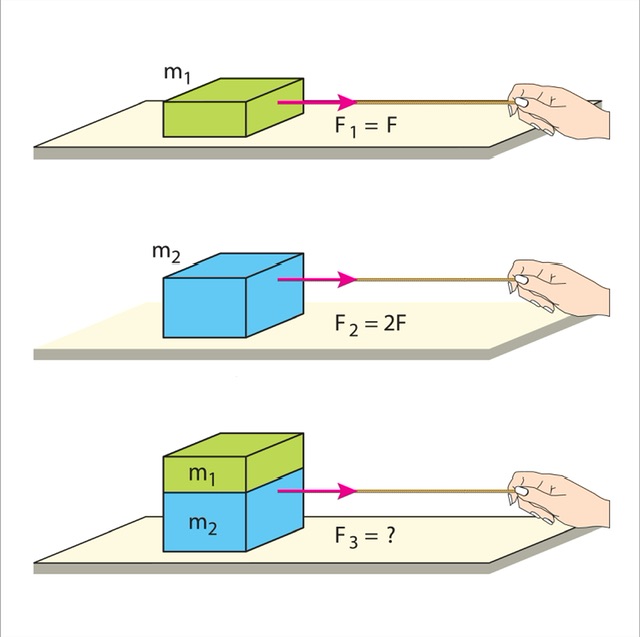We'll be back in a bit !
The system is currently undergoing a routine upgrade to ensure you get the best learning experience. The maintenance is expected to continue till 8:00 pm. Please check back later.
Thank you for your understanding!

Introduction
The study of forces acting on a system carries immense importance in Physics, particularly in Newtonian mechanics. By knowing these forces, we can fully understand the motion of the system and calculate velocity, acceleration, energy, etc.
In this article, we are going to try and understand what we mean by force. Further, we will also look at the different types of forces and their characteristics.
Force is a physical quantity that can change the state of motion of an object. For instance, it can set an object in motion, bring it to rest, or change its velocity. Further, the force can also alter the dimensions of the object. We define force as the push or pull experienced by an object owing to some external or internal effects.
Force is a vector quantity and thus, it is important to understand not only how much force is being applied, but also in what direction it is being applied. Generally, physicists use the symbol F to denote force and since it is a vector quantity, we add an arrow above it
The formula for heat energy is:
The point at which force is being applied is known as the point of action of force. In SI units, force is measured in Newtons (N), whereas some systems of units use dyne.Common examples of forces include gravitational force, electromagnetic force, nuclear force, etc.
When an object is in motion, the force acting on it is governed by Newton’s second law of motion, which relates the rate of change of momentum to the applied external force. Mathematically, we can write:
Here, is the force on the object, m is its mass, and represents its acceleration. Whenever an object is in motion, this relation is satisfied and we can also calculate a few other relations.
Where is the momentum of the object. This is the true expression of Newton’s second law which states that the rate of change of momentum is directly proportional to the applied external force. In SI units, the constant of proportionality is taken to be 1.
Newton’s second law also allows us to calculate the unit of force as follows:
Thus, the SI unit of force is kg.ms-2, which is also known as Newton and denoted by N. Dimensionally, this is equal to MLT-2.
As has been mentioned, Force can change the state of motion of a system or it can alter its dimensions. Note that changing the state of motion is possible in two different ways. This occurs because motion is related to velocity, which involves both direction and magnitude. Thus, to change the state of motion, we can:
Change the direction of motion.
Change the speed
When force is applied to a body, it has the following effects:
It can change the direction of motion of the body.
It can slow down or stop a moving object, which is equivalent to deceleration.
It can accelerate a system and increase its speed.
It can alter the shape and size of the system
Depending on how force is applied, it may be classified as follows:
Forces that require physical contact to be applied are known as contact forces. Common examples include mechanical force and frictional force.
Non-contact forces can affect a system even at a distance without physical contact. Some examples of this type of force are gravitational force, electromagnetic force, nuclear force, etc.
There are also a few other classifications of forces depending on different criteria. For instance, based on whether the force attracts or repels, we have attractive and repulsive forces. Based on whether the work done is path-dependent or not, we have conservative and non-conservative forces.
1. How much force is required to give 28 m/s2 acceleration to a bike of mass 200 kg?
2. A body has a mass of 50 kg and is moving with a velocity of 26 m/s. If it is acted upon by 200 N of force, how much time will be required to increase the speed to 38 m/s?
This time, we are given the mass, the force, and the change in velocity. We need to calculate the time taken for this change. To do this, we proceed as follows:
F=ma
200=50a
a=4 ms-2
Now, we can relate acceleration to changes in velocity and time.
3. An object’s momentum changes from 2760 kg m/s to 5760 kg m/s under the application of 50 N of force. The object has a mass of 120 kg. Find the time taken in minutes.
We are given the initial and final momenta of the object and we can use the following relation:
Force is a vector quantity that can alter the state of motion and/or shape and size of an object. It is a sort of push and pull and is measured in Newtons. Force is directly proportional to the time rate of change of momentum of a system and in SI units, the constant of proportionality is taken to be 1 unit.
1. Give an example of a non-contact attractive force?
Gravitational force is attractive and non-contact in nature
2. When we lift an object, what type of force do we apply?
We apply muscular force
3. What type of force does the earth apply?
Earth applies gravitational force on us.
4. Which is the strongest force in nature?
The nuclear force is the strongest force in nature but it is a very short-range force.
5. Which is the weakest force in nature?
Gravitational force is the weakest type of force in nature.
